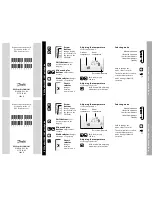
7.5 Encoder Divided Pulse Output
7.5.1 Encoder Divided Pulse Output Signals
7-19
7
Application Functions
Output Phase Forms
Note: The pulse width of the origin within one encoder rotation depends on the setting of number of encoder output
pulses (Pn212) or the encoder output resolution (Pn281). It is the same as the width of phase A.
Even for reverse operation (Pn000 = n.
1), the output phase form is the same as shown above.
Linear Encoder Application Precautions
The following precautions apply to the encoder output pulses when an external linear encoder
is used.
Relation between Renishaw PLC Incremental Linear Encoders and
Encoder Output Pulse Signal from the SERVOPACK When Using a
RGS20 Scale and RGH22B Sensor Head
The output position of the origin signal (Ref) will depend on the direction of movement for some
models of incremental linear encoders from Renishaw PLC.
In that case, the phase-C pulse of the SERVOPACK is output at two positions.
For detailed specifications on the origin signal, refer to the manual for the Renishaw PLC incre-
mental linear encoder.
When Passing the First Origin Signal (Ref) in the Forward Direction and Returning
after Turning ON the Power Supply
Forward rotation or movement
(phase B leads by 90
°
)
Reverse rotation or movement
(phase A leads by 90
°
)
If you use the SERVOPACK’s phase-C pulse output for an origin return, rotate the Servomotor
two or more rotations before you start an origin return. If the Servomotor cannot be rotated two
or more times, perform an origin return operation at a motor speed of 600 min
-1
or lower. If the
motor speed is higher than 600 min
-1
, the phase-C pulse may not be output correctly.
90
°
t
Phase A
Phase B
Phase C
90
°
t
Phase C
Phase B
Phase A
Important
Machine position (forward)
Origin detection
position
Origin detection
position
Power ON
Origin signal (Ref)
Phase C
The second pulse is half as
wide as the phase-A pulse.
Time
No origin signal (Ref) is output by the incremental linear
encoder. However, a phase-C pulse will be output from the
SERVOPACK when the motor moves in the reverse
direction, because this is the same position from which a
phase-C pulse was output when the motor moved in the
forward direction.
















































